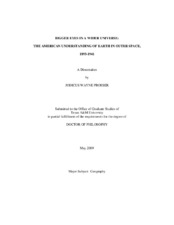| dc.description.abstract | Between 1893 and 1941, the understanding of the Milky Way galaxy within the
American culture changed from a sphere to a spiral and Earth's location within it changed
from the center to the periphery. These changes were based primarily upon scientific
theories developed at Mount Wilson Observatory near Pasadena, California. This
dissertation is an "astrosophy" that traces the history of changing depictions of the Milky
Way in selected published sources and identifies key individuals, theories and
technologies involved. It also demonstrates why the accepted depictions of the universe
envisioned at Mount Wilson were cultural-scientific products created, in part, as the
result of place.
Southern California became the hearth of a culture that justified its superiority
based upon its unique climate. Clear skies, remarkable visibility, and a perceived
existence of intense natural light became the basis for the promotion of Mount Wilson as
the premier location for astronomical observations. Conservation, en plein air paintings,
and the concept of paysage moralis are Southern Californian cultural products of the early 1900s that promoted an idealized society capable of exceptional intellectual
endeavors and scientific accomplishments.
The efforts of astronomers Hale, Shapley, Adams, Hubble and Ritchey resulted in
the changing American understanding of the universe. This dissertation reveals how the
diverse social interactions of these astronomers intersected Arroyo Seco meetings,
women's organizations, the Valley Hunt Club elites, and philanthropic groups that
comprised the schizophrenic culture of Pasadena. Their astronomical theories are
compared to other aspects of the Southern Californian culture revealed in the writings of
Raymond Chandler, Nathanael West and John Fante. The desire of astronomers to gain
prestige from their discoveries is compared to competition in the creative processes of
Hollywood. The theories created by astronomers and the films of the motion picture
industry relied upon establishing an accepted second space within the minds of their
audiences. By the end of the study period, the universe accepted by most Americans was
a "California Universe". It was not a discovery of pure science, but rather a culturalscientific
product of the Mount Wilson astronomers, the Pasadena community and the
landscape and culture of Southern California. | en |


